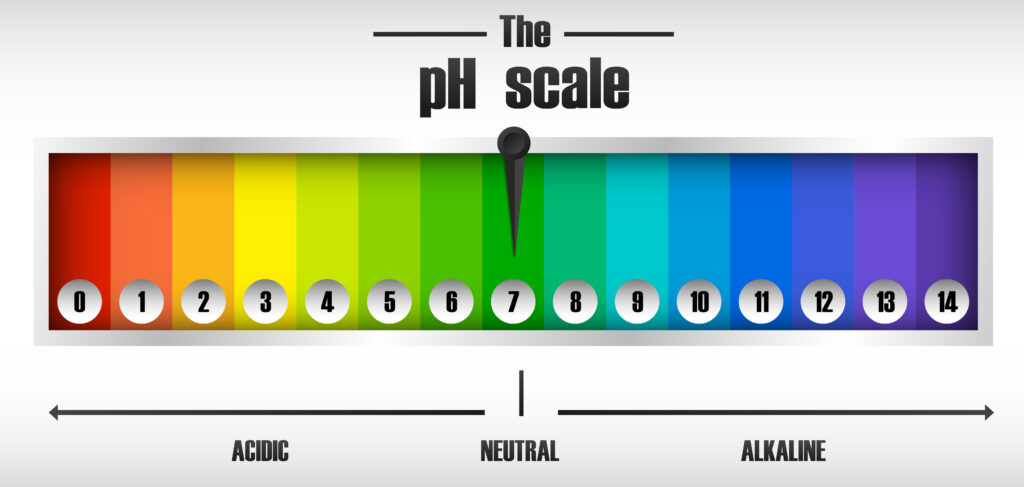Our bodies are a wonderland. Just think about how it has been meticulously designed with each organ and system playing a vital role. For everything to function smoothly, there are crucial elements that need to be in perfect harmony. One of those crucial elements is the body’s pH level.
You must have heard about pH levels in chemistry class, and now in discussions related to skincare products. But just so you know pH levels play a significant level in our body.
This blog delves into the significance of pH balance in the human body, explaining what it is, why it matters, and how our bodies maintain this delicate equilibrium.
pH: A measure of acidity and alkalinity
Recalling those chemistry lessons we had in school, pH stands for “potential of hydrogen” and is a measurement of the concentration of hydrogen ions (H+) in a solution. It acts on a scale ranging from 0 to 14, with 7 being neutral. Numbers below 7 indicate an acidic solution, while values above 7 signify an alkaline (basic) solution.
The human body functions its best in a slightly alkaline environment, with a narrow pH range of 7.35 to 7.45 for most bodily fluids like blood. This seemingly small range is critical for the optimal functioning of various biological processes.
Why does pH balance matter?
Maintaining a balanced pH is essential for several reasons:
Enzyme activity:
Enzymes are the workhorses of our cells, accelerating biochemical reactions necessary for life. Each enzyme functions best within a specific pH range. Even slight deviations from the ideal pH can significantly impede enzyme activity, disrupting vital processes.
Nutrient absorption:
The pH of your digestive system plays a crucial role in nutrient absorption. A healthy stomach environment with the appropriate acidity is necessary for breaking down food and absorbing essential nutrients.
Cellular function:
The pH inside our cells directly impacts their function. A balanced pH ensures proper protein structure, communication between cells, and waste removal.
Immune function:
A healthy pH level supports a robust immune system by promoting the activity of white blood cells that fight off infections.
How does the body maintain its pH function?
Our bodies are remarkably adept at maintaining pH balance despite the constant fluctuations. This task is accomplished by a sophisticated system called the buffer system.
The buffer system comprises a group of chemicals in the blood and other fluids that act like sponges, absorbing excess hydrogen ions (acidic) or releasing them (alkaline) to maintain a stable pH level.
The main players in the buffer system include:
Bicarbonate Buffer:
This is the primary buffer system in the blood, readily absorbing and releasing hydrogen ions to regulate blood pH.
Phosphate Buffer:
Plays a vital role in maintaining the pH of urine and other bodily fluids.
Protein Buffers:
Proteins in the blood and tissues also contribute to buffering capacity.
Factors affecting pH balance
While our bodies have incredible self-regulating mechanisms, certain factors can disrupt pH balance, leading to conditions known as acidosis (too acidic) or alkalosis (too alkaline). Here are some potential disruptors:
Diet:
A diet high in acidic foods like processed meats, sugary drinks, and some grains can increase the acid load in the body.
Chronic medical conditions:
Diabetes, kidney disease, and respiratory problems can all affect the body’s ability to maintain pH balance.
Medications:
Certain medications can affect kidney function or cause changes in the body’s acid-base balance.
Stress:
Chronic stress can increase the production of cortisol, a hormone with acidifying effects.
Dehydration:
Adequate water intake is crucial for maintaining proper blood volume and supporting the body’s natural detoxification processes.
Signs and symptoms of pH imbalance
While maintaining a healthy pH level is crucial, imbalances don’t always manifest with obvious symptoms. However, here are some potential indicators:
Acidosis:
Fatigue, nausea, headache, difficulty concentrating, and rapid breathing.
Alkalosis:
Confusion, muscle weakness, nausea, vomiting, and tingling or numbness in the hands and feet.
Maintaining Balance: What can you do to maintain optimal pH
While you can’t directly control your body’s pH, you can adopt healthy habits that support its natural buffering mechanisms:
Prioritise a balanced diet:
Focus on a diet rich in fruits, vegetables, and whole grains with moderate amounts of lean protein. These foods tend to have an alkalising effect on the body.
Hydrate adequately:
Aim for eight glasses of water daily to ensure proper kidney function and support the body’s natural detoxification processes.
Manage stress:
Chronic stress can contribute to an acidic environment. Practice stress-reduction techniques like yoga, meditation, or deep breathing exercises.
Limit processed foods:
Processed foods, sugary drinks, and excessive red meat consumption can increase the body’s acid load. Opt for whole, unprocessed food.
Do different organs have different pH levels?
Different organs perform their finest at their optimal level of pH. For instance, the enzyme pepsin requires a low pH to function and break down food, while the enzymes present in the intestine require a high pH or alkaline environment to function. The vagina has a moderate acidic pH level between 3.8 and 5. However, this can vary based on your age, menstrual cycle, and menopause.
Closing thoughts
Understanding pH balance helps you understand the inner workings of your body. By including simple strategies like focusing on a balanced diet, staying hydrated, and managing stress, you can support your body’s natural buffering system and keep the pH balanced. Remember, a balanced pH is a cornerstone of good health.





